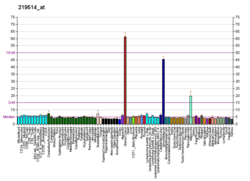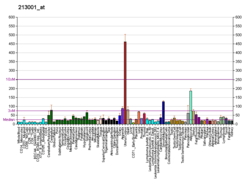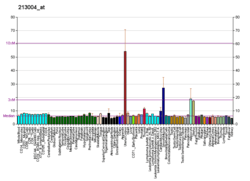Angiopoietin-related protein 2 also known as angiopoietin-like protein 2 is a protein that in humans is encoded by the ANGPTL2 gene.[5][6]
Function
Angiopoietin-like protein 2 maintains tissue homeostasis by promoting adaptive inflammation and subsequent tissue reconstruction, whereas an excess of ANGPTL2 activation induced by prolonged stress promotes the breakdown of tissue homeostasis due to chronic inflammation, promoting the development of metabolic diseases. ANGPTL2 has a role also in angiogenesis, in tissue repair, in obesity, in atherosclerotic diseases and finally in cancerogenesis.
[7]
Angiopoietins are members of the vascular endothelial growth factor family and the only known growth factors largely specific for vascular endothelium. Angiopoietin-1, angiopoietin-2, and angiopoietin-4 participate in the formation of blood vessels. ANGPTL2 protein is a secreted glycoprotein with homology to the angiopoietins and may exert a function on endothelial cells through autocrine or paracrine action.[6]
References
- 1 2 3 GRCh38: Ensembl release 89: ENSG00000136859 - Ensembl, May 2017
- 1 2 3 GRCm38: Ensembl release 89: ENSMUSG00000004105 - Ensembl, May 2017
- ↑ "Human PubMed Reference:".
- ↑ "Mouse PubMed Reference:".
- ↑ Kim I, Moon SO, Koh KN, Kim H, Uhm CS, Kwak HJ, Kim NG, Koh GY (Oct 1999). "Molecular cloning, expression, and characterization of angiopoietin-related protein. angiopoietin-related protein induces endothelial cell sprouting". J Biol Chem. 274 (37): 26523–8. doi:10.1074/jbc.274.37.26523. PMID 10473614.
- 1 2 "Entrez Gene: ANGPTL2 angiopoietin-like 2".
- ↑ https://www.clinicalkey.com/#!/content/playContent/1-s2.0-S1043276014000599?returnurl=http:%2F%2Flinkinghub.elsevier.com%2Fretrieve%2Fpii%2FS1043276014000599%3Fshowall%3Dtrue&referrer=https:%2F%2Fwww.ncbi.nlm.nih.gov%2F
Further reading
- Andersson B, Wentland MA, Ricafrente JY, et al. (1996). "A "double adaptor" method for improved shotgun library construction". Anal. Biochem. 236 (1): 107–13. doi:10.1006/abio.1996.0138. PMID 8619474.
- Zeng L, Dai J, Ying K, et al. (2003). "Identification of a novel human angiopoietin-like gene expressed mainly in heart". J. Hum. Genet. 48 (3): 159–62. doi:10.1007/s100380300025. PMID 12624729.
- Humphray SJ, Oliver K, Hunt AR, et al. (2004). "DNA sequence and analysis of human chromosome 9". Nature. 429 (6990): 369–74. doi:10.1038/nature02465. PMC 2734081. PMID 15164053.
- Sun H, Zheng JM, Chen S, et al. (2007). "Enhanced expression of ANGPTL2 in the microvascular lesions of diabetic glomerulopathy". Nephron Exp. Nephrol. 105 (4): e117–23. doi:10.1159/000100493. PMID 17347581.






